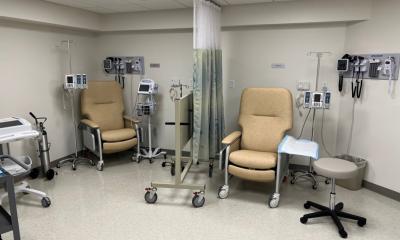International philosophies and hospital construction
Philippe PIENS, Hospital Facilities Programmer at the Paris-based healthcare facility organisation and design feasibility advisory company HospiConseil, describes conflicting cross-border concepts and compromises, during the planning of a new, state-of-the-art maternity unit at the King Hamad General Hospital, Bahrain

In 2002, the Bahraini government opened an international competition in 2002 for the design and construction of a new 300-bed hospital in the Muharraq District of Manama in Bahrain. Among two short-listed candidates, our French team was selected over an Australian group.
During the inception meeting in Manama, the Bahrain Under Secretary for Health said we had been chosen to provide his country with the best French, state-of-the-art hospital know-how. As the HospiConseil hospital programmer, naturally I had to wonder what was so specific about French hospitals, and that brought a surprising discovery, which I would like to share. The Bahraini Health Ministry had a North American advisor, whom I met. With uncompromising honesty he told me that he preferred Australian hospital technology, but was out-voted in the selection. However, he hoped that we would consider the North American labour, delivery and recovery (L, D & R) concept in our design of the maternity centre for the new hospital, since that concept was increasingly accepted in Bahrain.
Indeed, the staff of the existing Muharraq maternity and of the more recent Jidd Haffs Obstetrics hospital made use of facilities designed in a configuration akin to L, D & R: the many labour rooms were used for all the phases of birth, pre-labour monitoring, labour, delivery and recovery. However, the size of the delivery centre resulting from the many delivery rooms was perceived as a problem by midwives and doctors. A lack of labour room availability sometimes drove the staff to transfer recovering mothers to a separate area of the unit.
I remembered, from my time spent in Los Angeles, the delivery suites provided - given the right health insurance. The natural birth movement of the 80s had incited many US women to deliver at home, rejecting the cold and inhuman feel of hospital labour units. Birth was considered a normal part of life, not a disease.
That wave of home births resulted in some accidents. Hospitals then strove to offer a ‘home’ environment - with access to medical amenities in cases of need - within their walls. As a result, delivery suites were decorated like expensive hotel suites, with wood panelling, glass-topped credenzas, curtained windows and thick carpeting. At a pinch, the wainscot would reveal oxygen and vacuum outlets, anaesthetics paraphernalia, as well as necessary medical devices for an emergency delivery.
The challenge thus became how to reconcile the highly clinical French labour environment, entirely geared towards a potential emergency, with the woman-centred natural birth approach embodied in the L, D & R concept.
I devised a possible compromise, where women were placed, according to prognosis, either in delivery suites, according to the L, D & R concept, or in an ‘intensive care’ labour unit - similar to the French obstetrics block.
I put the question to our team’s medical expert. After several phone calls to some of the most renowned French obstetricians, his verdict was, without question, that the L, D & R nonsense should be dismissed in the face of the priority - perinatal safety. When asked to arbitrate, our Bahraini protagonists simply repeated: ‘Do your best French thing.’
I now realise now that French expertise leaves so little room for compromise due to a fundamental feature of French society - which goes back to the French revolution, and the permanency it preserved in the French way of thinking. Inspired by philosophers (les lumières), the French revolution tried to replace Catholicism, the state religion, with the culte de l’être suprême, the cult of the supreme being. Represented by an eye within an equilateral triangle, the supreme being was the fountainhead for raison universelle, universal rationality.
Universal rationality should not be confused with consensus, for the latter is generated within a population. Universal rationality is above individuals. It belongs to the State, to the valeurs républicaines mentioned by politicians whenever they all agree to disagree with one particular individual.
One could argue that birth is, by nature, specific to women and, therefore, that women should decide how it should be done. Few French people would disagree with that, but would disregard such a notion as being non-universal, women being some humans but not all humans. There must be some universal truth about hospital labour units, just like anything else. Where do the French turn to find such universal truth? To the Faculté of course, to the learned. These wise men (few women) disagree so often with one another that, when they do agree, then it must be universally reasonable.
In spite of this norm (perhaps overly described here)n), the thinking of health professionals is evolving and some new features are appearing in French hospitals. In terms of birth, the new trends seem to blow in on the North wind, from our European partners. (In Germany, the labour bed tends to be replaced by a multi-position platform resembling something from a fitness centre).
Prevention of risk through training and diet are generalised. In the labour room, the baby care station is designed as a mobile unit so that ministrations to the new-born can be performed in front of the mother.
The midwife is seen less and less as a nurse and her status as a practitioner is more recognised. The time she spends with the parturient is seen as an important factor in a successful birth. The design of labour units is geared towards limiting the time away from the delivery room and the new legislation requires a full night staff, so that midwives are not - alone in the complete running of a labour unit.
France’s poor record of perinatal safety is improved through the concentration of maternity cases in fewer and better-equipped facilities. However, such a medico-technical approach does not preclude research for higher quality care, seen by some as the real source of perinatal safety.
30.04.2003





